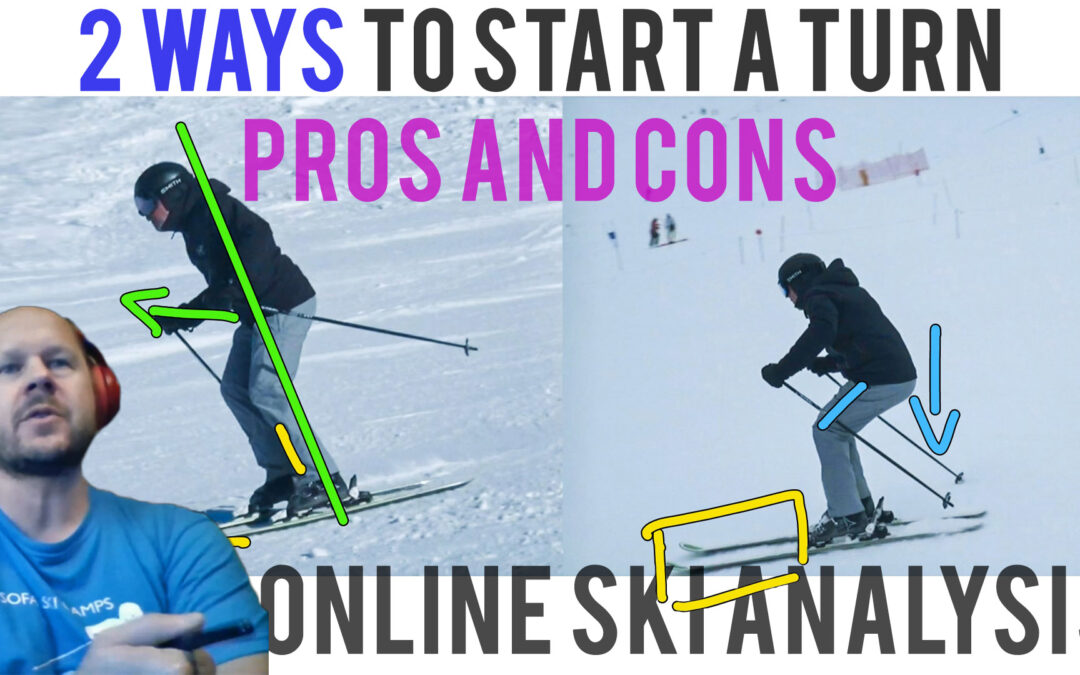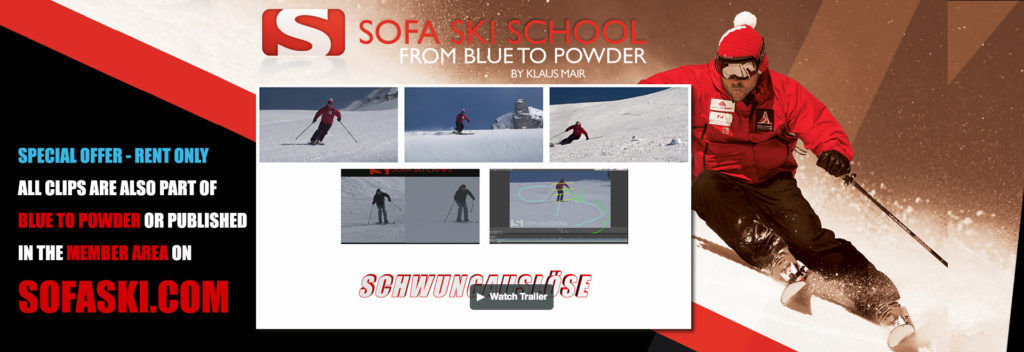Sometime this winter one of our Sofa Ski Camp participants from New Zealand sent me a video of himself skiing Mammoth together with this note:
“Hi Klaus I know you are super busy but something is wrong with me in this clip, I look like I’m rushing the turns? I want to look like those guys at Interski . Any simple tips to work on with my short turns for my last couple of days here in Mammoth? If you don’t have time no stress… cheers!”
Although it was in the middle of my busy Austrian season, I wanted to give him some quick feedback and got carried away a bit.
When Cam joined us for the first time in NZ he had already done a ski tech camp in Australia. In his first pre camp analysis that I sent him I pointed out that he gets pulled too much to the back and inside especially on his left footers and that we will add more forward movement in the transition by changing his turn initiation. www.skianalysis.com
During his camp in NZ he trained with Don Christian Pessl and it was great to see how quickly he could add this to his skiing and how this allowed him to stay more in balance throughout the turn, how he got more power on his outside ski and how his A-frame improved considerably. www.sofaskicamps.com
I had to smile when he sent me the clip from Mammoth together with his comment that he would like to look like the Interski guys. The Interski in Bulgaria was underway and on a daily basis demo runs from the different nations popped up on my FB. Some great and some not so great. Obviously it seems to be a bit of a trend in the ski instructor world to do flex and release turns on slalom skis these days and the video Cam sent me together with his comment made a lot of sense.
The original video of the Interski Congress used in this clip can be found on the YouTube Channel of NZSIA SKI: https://youtu.be/0gu0aYtVwCI
As explained in my video Flex to Release and Up and Forward are two different techniques to create release and get the skis into the new turn. The one is not better than the other and they have always been around and are certainly not the invention of someone or something especially new or revolutionary.
In times when skis were a lot longer the process of getting them into the new turn took a bit more than today. The Hochentlasten (up-unweighting) and Tiefentlasten (down-unweighting) were key terms in the Austrian ski teaching system and nothing else then the FtR and UaF I am referring to here.
With carving skis those moves became less important and some even thought that creating release at the start of the turn was not necessary anymore at all.
Like with all changes in skiing it turned out that we did those things back then for a reason and while the skis have changed, biomechanics and physics did not. What they figured out back then is still relevant, the movements might be more subtle but still work in the same way and help the beginner as well as the world cup racer (Exactly the same applies to the discussions around stance, the alpine basic position or how we balanced and still balance over the outside ski,…).
The reason why I explain this in length is because when there are trends or new techniques in skiing there is often the tendency to believe that everything has changed now and that the en vogue turn is now the only one that should be taught and done. Regarding this topic, some instructors think that vertical movement is the worst thing that a skier can do and that the expert skier always wants to stay low and avoid any unneccessary extension. The World Cup skiers show us that the opposite is the case and that the extension forward is still one of the key moves to win races. I tried to show in my video that both techniques are still just as relevant, that they both have their benefits and that the complete skier uses the one as well as the other.
What we work on with an athlete always depends on where he is at and what is going on in his turn. For Cam it made a huge difference to add more forward in his initiation. With someone else we might add more flex and release to their turn to achieve the next breakthrough. For me as a coach it is most important that the skiers I work with understand skiing and are able to adjust and choose which technique they are using in which situation.
Having said this I have to add that in ca 90% of my lessons the main focus when working on the turn initiation is on the up and forward initiation and maybe 10% on the retraction extension. For us the moving forward into the new turn, getting neutral and forward in the transition is the basic version of getting a turn started and once skiers are able to do this clean in various situations, they will have all the options. To initiate by a clean up and forward builds the fundament for all levels as it makes it a lot easier to find the outside ski, to be able to stay forward and in balance, to have more control in the steeps and more performance across all turns. Not being able to do this clean is one of the biggest reasons why skiers get stuck and struggle to improve.
I am teaching skiing since 1990 and during the last 5 years I have been working with over 350 recreational skiers each year and every lesson was also a learning experience for me. I would add the flex to release as another way of doing it when working on short turns, bumps and powder on the expert level but only after the skier is able to re-center and gets to a clean neutral position in between turns. More information on how I teach the start of the turn from blue to black can be found on www.bluetopowder.com.
As ski instructors we have a big responsibility to improve the ways we can help skiers of all levels get more out of the sport. We constantly try to find out what works best, what is most efficient and most achievable to learn. It is not about looking especially good or trying to impress with spectacular hip on the snow moves, our job is to help recreational skiers ski better.
Every ski school manager I know complains that there are only very few experienced skiers that are interested in taking lessons. On the other hand lots of people quit skiing as they are scared of injury or simply don’t enjoy it as much anymore as when they were younger.
Why is it that so few of those decide to work on their skills and take a lesson?
What’s the percentage of skiers that you watch from the chairlift that should really take a lesson?
Why is it that most of them would never even think about it?
Could we do a better job in helping them improve?
But now I really got carried away. 😊 Back to work.
The second part of the video above and more ski tech articles and videos can be found in the member area on www.SOFASKI.COM
Have a great day,
The original analysis + Part 2 of this video
are available to customers in the
SOFASKI.COM – Member Area
OR CAN BE ACCESSED through the
ALL INITIATION CHAPTERS – SPECIAL OFFER below
Cam’s email after the ski trip:
“Hi Klaus, I don’t know how to thank you enough for the time you spent on my video… I really needed this and you’ve pulled me back to where I should be (up and forward instead of extension/retraction making me back). I managed to watch the video (the first time) on the Gondola up to do Dave’s Run and when I got back on the groomers I threw away what I was trying to do (ski like interski) and went back to what you’ve taught me. It feels like I’m skiing a little bit taller but my speed control and edging (finding the outside ski early and staying on it easier) was so much better so your methods definitely work better for me. One thing that’s really blown me away is how much my steeps skiing has improved since your Camp last year in TC. So much more confident and in control down the steeps! Thanks again and you are a true professional running an exceptional school. I am almost certain I will come to Austria this Christmas to do another camp with you if you can put up with me twice in 6 months. I have one more morning out there tomorrow at Mammoth before flying home tomorrow night and then I will see you at TC. Cheers!”
YOUR RESULTS ARE OUR SUCCESS
TURN INITIATION PACKAGE – SPECIAL OFFER:
If you don’t want to commit to the purchase of Blue to Powder this might be a good option to trial Sofa Ski School ski instructionals:






Klaus, I am an old DVD follower from a decade ago. I dream of taking lessons with you. Just a question: are drones allowed in Europe/Austria or in New Zealand. They outlawed in the US. There are drones that can follow their subject whether biking skiing, etc. I truly think follow along video can bring immediate feedback, correction and quicker improvement. Theoretically with wifi communication headsets you could instruct while observing your student. Instant feedback. Every run is valuable on lesson day.
Hi Dan, thank you for your comment! Drones are allowed in Austria, but there are certain rules depending on how big the drone is.
I like your thoughts about immediate feedback audio as well as visual. I am using helmet intercoms from Uclear in 90% of my lessons https://sofaski.com/de/produkt/hbc220force-bluetooth-snowsports-audio-system-dual-kit/ Which is a real game changer to how you can teach on snow.
While setting up a drone would take too long in a lesson, I can get most angles with my GoPro mounted to my ski pole. I have it always on the pole and whenever i see something that i would like to share with my student i will film it. I can hold it above the skier, from below,… any angle. On the lift i will stream it to my phone and we have a look at the video together.
Here is an article where i show some of it:
https://sofaski.com/filming-skiing-with-action-cams-behind-the-scenes/
Have a great winter!
Klaus